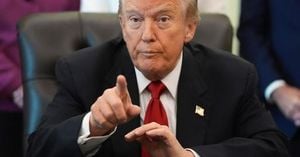India’s economic landscape is shifting rapidly, with new data and government announcements painting a picture of both challenge and opportunity for investors, businesses, and ordinary citizens. On August 19, 2025, a series of reports and government briefings revealed the complex interplay between corporate earnings, infrastructure investment, and policy reforms that continue to shape the nation’s growth trajectory.
According to a recent analysis by Motilal Oswal, smallcap companies in India faced a tough first quarter in 2025. Out of 132 smallcap firms tracked, earnings dropped by 11% year-on-year, with nearly half missing analyst estimates. Sectors such as private banks, NBFCs (both lending and non-lending), insurance, oil and gas, and automobiles were particularly hard-hit, posting year-on-year declines. "Smallcaps (132 companies) continued to experience weakness and a broad-based miss, with private banks, NBFCs (lending and non-lending), Insurance, Oil & Gas, and Automobiles posting a YoY earnings decline. The smallcap earnings dipped 11% YoY (our estimate of flat growth), with 46% of the coverage universe missing our estimates," Motilal Oswal stated, as reported by The Economic Times.
But while smallcaps struggled, midcap companies emerged as the clear winners. Motilal Oswal’s report highlighted that 92 midcap companies delivered a robust 24% year-on-year earnings growth in Q1, outpacing expectations. Seventeen out of twenty-two sectors under coverage posted double-digit profit after tax (PAT) growth, with oil and gas, public sector banks, NBFCs, metals, and IT leading the charge. These sectors accounted for a staggering 89% of the incremental year-on-year earnings increase.
Meanwhile, the Nifty index told a more nuanced story. For the fifth consecutive quarter, Nifty companies posted only single-digit earnings growth. More concerning, says Motilal Oswal, was the concentration of this growth: "Five Nifty companies – Bharti Airtel, Reliance Industries, SBI, HDFC Bank, and ICICI Bank – contributed 77% of the incremental YoY accretion in earnings," the brokerage highlighted. This points to a narrowing growth base, raising questions about the broader health of India’s corporate sector.
Despite these mixed signals, analysts see reasons for optimism in the months ahead. Hiren Ved of Alchemy Capital offered a cautiously hopeful outlook: "The big hope is that in second half on back of good monsoon, better liquidity, lower rates, we start to see better numbers coming out in the second half and as the base of earnings in the second half is also lower." He predicted that while the first half of FY26 might remain neutral, the third quarter could see a significant uptick in consumption-driven earnings.
This sense of cautious optimism is echoed by Sumit Bhatnagar, Fund Manager at LIC MF. "The key takeaway for us is that the earning downgrade cycle or the pace of earnings downgrade is getting slower and probably we are in a bottom quarter or maybe the Q2 can be the bottom quarter for earning downgrade per se and from here on we expect the earnings to pick up gradually," Bhatnagar explained. He also noted that, by traditional valuation measures, Indian markets remain fairly priced compared to long-term averages and other emerging markets, giving investors some comfort amid the volatility.
Government policy is another crucial variable. Prime Minister Narendra Modi’s recent announcement on GST reforms has injected fresh enthusiasm into consumption-oriented sectors such as autos, cement, consumer durables, FMCG, and financials. Brokerages are adjusting their portfolio strategies accordingly. Motilal Oswal, for instance, has maintained a strong tilt toward large-caps (70% portfolio weight) but has also increased its allocation to midcaps (now 22%, up from 16%) due to their superior earnings performance. The firm is overweight on BFSI, consumer discretionary, industrials, healthcare, and telecom, while underweight on oil and gas, cement, real estate, and metals.
Global investment houses are also watching closely for catalysts that could spur a market rebound. Jefferies predicts a strong recovery in the September 2025 quarter, citing both a low base effect—due to weak government spending during last year’s elections—and the fact that Diwali will occur 12 days earlier this year, potentially boosting quarterly demand. Emkay Global, meanwhile, sees the GST reforms as a game-changer: "The GST rationalization offsets near-term worries on weak growth and tepid earnings. The six-week downtrend should now reverse, as i) the outlook for earnings improves considerably, and ii) valuations will factor in the broader positives of this big-ticket reform measure." Emkay is particularly bullish on consumer discretionary stocks and prefers small and midcaps in the staples and cement segments within materials.
While the market digests these signals, the Indian government is doubling down on its infrastructure push—a strategy that policymakers argue has helped insulate the economy from global shocks. Union Minister Ashwini Vaishnaw, speaking at a Cabinet briefing on August 19, 2025, said, "To lay the foundation of Viksit Bharat, PM Narendra Modi has approved infrastructure projects worth ₹10.74 lakh crore in the third term. The entire world opted for a consumption-based solution post Covid, but PM Modi implemented an infrastructure-based solution." Vaishnaw credited this approach with keeping India on a "high growth trajectory" despite global economic uncertainty, and noted that India’s sovereign ratings have been upgraded for the first time in eighteen years—a testament, he said, to the agility and resilience of the Indian economy.
Specific infrastructure projects continue to roll out at a rapid pace. The Cabinet has just approved the construction of a new airport in Kota, Rajasthan, at a cost of ₹1,507 crore, with completion expected in two years. The Rajasthan government has already transferred 440.06 hectares of land to the Airports Authority of India for this greenfield development, which will be capable of handling A-321 type aircraft. The project includes a 20,000 square meter terminal building designed to accommodate 1,000 peak hour passengers and handle up to 2 million passengers annually. In addition, the Cabinet greenlit a six-lane access-controlled ring road in Cuttack and Bhubaneshwar, with an investment of ₹8,307 crore.
India’s infrastructure-based growth policy, Vaishnaw argued, was crucial in helping the country weather the COVID-19 economic storm better than many other nations. As the world’s fastest-growing major economy, India’s resilience is also reflected in its billionaire rankings. According to Fortune India, the number of dollar billionaires dipped slightly from 185 to 182 this year, but the entry threshold for the Top 100 rose to ₹24,283 crore, up from ₹22,739 crore last year—a sign of growing wealth concentration at the top even as the broader economy faces headwinds.
For investors and policymakers alike, the message is clear: India’s growth story is being shaped by a delicate balance of corporate performance, government policy, and infrastructure investment. As smallcap investors lick their wounds and midcaps bask in the glow of outperformance, all eyes are on the second half of the fiscal year—and the hope that reforms, infrastructure, and a bit of festive cheer will deliver the next leg of India’s economic ascent.




